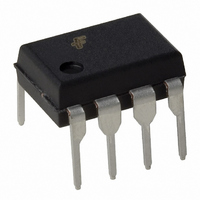FSQ0370RNA Fairchild Semiconductor, FSQ0370RNA Datasheet - Page 9

FSQ0370RNA
Manufacturer Part Number
FSQ0370RNA
Description
IC SWIT PWM GREEN OVP UVLO 8DIP
Manufacturer
Fairchild Semiconductor
Series
FPS™r
Specifications of FSQ0370RNA
Output Isolation
Isolated
Frequency Range
92kHz ~ 108kHz
Voltage - Input
9 V ~ 20 V
Voltage - Output
700V
Power (watts)
27W
Operating Temperature
25°C ~ 140°C
Package / Case
8-DIP (0.300", 7.62mm)
Power Switch Family
FSQ0370
Power Switch On Resistance
4Ohm
Output Current
970mA
Number Of Outputs
Single
Mounting
Through Hole
Supply Current
3mA
Package Type
PDIP
Operating Temperature (min)
-25C
Operating Temperature (max)
85C
Operating Temperature Classification
Commercial
Pin Count
8
Power Dissipation
1.5W
On Resistance (max)
4 Ohms
Maximum Operating Temperature
+ 85 C
Minimum Operating Temperature
- 25 C
Maximum Power Dissipation
1500 mW
Mounting Style
Through Hole
Lead Free Status / RoHS Status
Lead free / RoHS Compliant
Available stocks
Company
Part Number
Manufacturer
Quantity
Price
Company:
Part Number:
FSQ0370RNA
Manufacturer:
FSC
Quantity:
81 000
Part Number:
FSQ0370RNA
Manufacturer:
FAIRCHILD/仙童
Quantity:
20 000
FSQ0170RNA, FSQ0270RNA, FSQ0370RNA Rev. 1.0.2
© 2006 Fairchild Semiconductor Corporation
Functional Description
1. Startup: In previous generations of Fairchild Power
Switches (FPS™), the V
resistor to the DC input voltage line. In this generation,
the startup resistor is replaced by an internal high-
voltage current source and a switch that shuts off 10ms
after the supply voltage, V
source turns back on if V
2. Feedback Control: The 700V FPS series employs
current-mode control, as shown in Figure 14. An opto-
coupler (such as the H11A817A) and shunt regulator
(such as the KA431) are typically used to implement the
feedback network. Comparing the feedback voltage with
the voltage across the R
an offset voltage, makes it possible to control the
switching duty cycle. When the shunt regulator reference
pin voltage exceeds the internal reference voltage of
2.5V, the opto-coupler LED current increases, the
feedback voltage V
reduces the duty cycle. This typically happens when the
input voltage increases or the output load decreases.
V
3. Leading Edge Blanking (LEB): When the internal
SenseFET is turned on, the primary-side capacitance
and secondary-side rectifier diode reverse recovery
typically cause a high-current spike through the
SenseFET. Excessive voltage across the R
leads to incorrect feedback operation in the current-
mode PWM control. To counter this effect, the FPS
employs a Leading Edge Blanking (LEB) circuit. This
circuit inhibits the PWM comparator for a short time
(t
O
FSQ0x70RNA Rev. 1.00
LEB
) after the Sense FET is turned on.
Figure 14. Pulse Width Modulation Circuit
Figure 13. High-Voltage Current Source
431
C
FB
FB
V
3
IN
5μA
V
,dc
+
-
V
FB
V
FB
cc
V
SD
CC
D1
sense
CC
is pulled down and thereby
V
str
CC
10ms after
UVLO on
UVLO off
V
V
drops below 8V.
V
900μA
FB,in
CC
cc
cc
D2
FSQ0x70RNA Rev. 1.00
≥ 12V
<8V
resistor of SenseFET, plus
pin required an external
, goes above 12V. The
2.5R
R
I
STR
OSC
I
CH
OLP
V
J-FET
str
sense
driver
Gate
resistor
9
4. Protection Circuits: The FPS has several protective
functions, such as Overload Protection (OLP), Over-
Voltage
(UVLO), and Thermal Shutdown (TSD). Because these
protection circuits are fully integrated in the IC without
external components, reliability is improved without
increasing cost. Once a fault condition occurs, switching
is terminated and the SenseFET remains off. This
causes V
voltage, V
the internal high-voltage current source charges the V
capacitor via the V
start voltage, V
its normal operation. In this manner, the auto-restart can
alternately enable and disable the switching of the power
SenseFET until the fault condition is eliminated.
4.1 Overload Protection (OLP): Overload is defined as
the load current exceeding a pre-set level due to an
unexpected event. In this situation, the protection circuit
should be activated to protect the SMPS. However, even
when the SMPS is operating normally, the OLP circuit
can be activated during the load transition. To avoid this
undesired operation, the OLP circuit is designed to be
activated after a specified time to determine whether it is
a transient situation or a true overload situation. In
conjunction with the I
current mode feedback path limits the current in the
SenseFET when the maximum PWM duty cycle is
attained. If the output consumes more than this
maximum power, the output voltage (V
below nominal voltage. This reduces the current through
the opto-coupler LED, which also reduces the opto-
coupler transistor current, thus increasing the feedback
voltage (V
diode is blocked and the 5µA current source (I
starts to slowly charge C
V
operation is terminated, as shown in Figure 15. The
shutdown delay time is the time required to charge C
from 3V to 6V with 5µA current source.
4.2 Thermal Shutdown (TSD): The SenseFET and the
control IC are integrated, making it easier for the control
V
6V
3V
FB
FB
increases until it reaches 6V, when the switching
FSQ0x70RNA Rev.00
t
Figure 15. Overload Protection (OLP)
12
CC
Protection
STOP
FB
=
C
). If V
to fall. When V
FB
t
1
V t
START
(typically 8V), the protection is reset and
( )
I
2
DELAY
str
−
FB
V t
pin. When V
( )
(typically 12V), the FPS resumes
(OVP),
PK
1
exceeds 3V, the feedback input
t
12
;
FB
= C
current limit pin (if used), the
I
DELAY
Overload Protection
FB
up to V
CC
×
(V(t
Under-Voltage
=
reaches the UVLO stop
2
)-V(t
5
CC
μ
A V t
CC
1
, ( )
)) / I
reaches the UVLO
. In this condition,
DELAY
1
=
O
3 , ( )
www.fairchildsemi.com
V V t
) decreases
2
Lockout
t
=
DELAY
2
6
V
CC
t
FB
)












